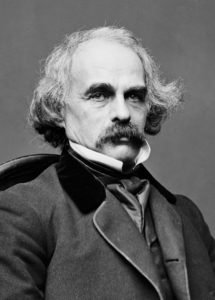Hawthorne's Young Goodman Brown Symbolism and Analysis
Before Discussing Symbolism in “Young Goodman Brown”
The time period which Hawthorne wrote in was known as the Romantic Period. Characteristics of the American Romantic period include a fascination with the supernatural, an impulse toward reform, the celebration of the individual, a reverence for nature, and the idealization of women (for a more in depth look at American Romanticism, follow the above link). Keep reading for an in depth look at Hawthorne’s Young Goodman Brown Symbolism. [caption id=“attachment_130501” align=“aligncenter” width=“500”] Nathaniel Hawthorne[/caption]
Nathaniel Hawthorne[/caption]
Important Symbols
Faith - We’ll start with an easy one. Young Goodman Brown’s wife is an obvious symbol for Young Goodman Brown’s faith. Although Brown dies a bitter man, blaming the wickedness and hypocrisy of others, he leaves his Faith first. Young Goodman Brown - This too is a hammer over the head symbol. Young Goodman Brown symbolizes the innocence of young, good men, who are all tempted and to some extent all give in. Brown’s journey, therefore, represents the loss of innocence (We’ll talk about this more when we discuss allegory in “Young Goodman Brown.”). The Forest - Puritans believed the woods to be the habitat of the devil. The woods in “Young Goodman Brown” are an obvious symbol of the devil’s abode. It can be construed further as the journey into sin and darkness continues. Salem - Salem remains the most notorious colonial town in American History, famous for its witch trials in 1692 (dramatized brilliantly by Arthur Miller in <em>The Crucible</em>). At the core of the Salem Witch Trials was the hypocrisy of the town’s more prominent citizens and the stupidity and pride of the town’s clergy in encouraging the trials to take place. It would not be a stretch, therefore, to assume that the “good people” of Salem would have communed with the devil (symbolically speaking). Hawthorne had a personal connection with the trials, being a descendant of one of Salem’s prominent judges who sentenced several “witches” to death.
Allegory
Now that we’ve identified several cases of Young Goodman Brown symbolism, it’s time to take our discussion one step further by discussing allegory. For those of you who have forgotten, an allegory is a story in which everything is a symbol. Following are a few allegorical interpretations of the story.
- Young Goodman Brown can be thought of as a 19th-century version of a morality play. Morality plays were famous in Europe in the 15th and 16th centuries and were characterized by the protagonist–Young Goodman Brown–being met by the personification of moral attributes–Faith and the Devil. Young Goodman Brown leaves Faith and ventures into the forest where he is confronted by the devil. Young Goodman Brown differs from a morality play insomuch that although he chooses the right eventually, he is not rewarded for it.
- The most obvious allegorical interpretation of “Young Goodman Brown” involves the loss of innocence. Brown is stunned when he discovers that even the righteous among him have given in to temptation at some point. This discovery is a trial of one’s faith, a trial that Brown ostensibly fails.
- I wrote a paper in college on how “Young Goodman Brown” was an allegory for the occurrence of a Great Apostasy that occurred in Christendom, citing numerous Biblical examples that the history of Christianity consists of apostasy followed by reconciliation through prophetic warnings or the coming of the Messiah himself. Young Goodman Brown searches for truth but finds only corruption in the same way Christians searching for a true church would be unable to find it until the return of a prophet. My grade suffered an apostasy and the ‘D+’ was never reconciled to the ‘A’ I deserved, so you may not want to include this interpretation in your next essay.
Feel free to share your thoughts on “Young Goodman Brown” or my interpretations of its symbols by adding a comment below. Image of Nathaniel Hawthorne by Mathew Brady
This post is part of the series: Study Guide for Nathaniel Hawthorne’s Short Stories
Nathaniel Hawthorne’s short stories are rich in meaning. Understand them better with these study guides.
